Mitsubishi Outlander: DTC B1C33, B1C34, B1C35, B1C36, B1C38, B1C39, B1C3A, B1C3B
DTC B1C33: Driver's Lap Pre-tensioner (Squib) System (Shorted to Squib Circuit Ground)
Driver's Lap pre-tensioner (Squib) Circuit


CAUTION If DTC B1C33 is set in the SRS-ECU, always diagnose the CAN main bus line.
CIRCUIT OPERATION
The SRS-ECU judges how severe a collision is by detecting signals from the front impact sensors and the front air bag analog G-sensor. If the impact is over a predetermined level, the SRS-ECU sends an ignition signal. At this time, if the front air bag safing G-sensor is on, the lap pre-tensioner will deploy.
DTC SET CONDITIONS
This DTC is set if there is abnormal resistance between the input terminals of the lap pre-tensioner (squib).
TROUBLESHOOTING HITS
- Damaged wiring harnesses or connectors
- Short to the ground in the lap pre-tensioner (squib) harness
- Malfunction of the SRS-ECU
DIAGNOSIS
Required Special Tools:
- MB991958: Scan Tool (M.U.T.-III Sub Assembly)
- MB991824: Vehicle Communication Interface (V.C.I.)
- MB991827: M.U.T.-III USB Cable
- MB991910: M.U.T.-III Main Harness A (Vehicles with CAN Communication System)
- MB991865: Dummy resistor
- MB991884: Resister harness
STEP 1. Using scan tool MB991958, diagnose the CAN bus line.
CAUTION To prevent damage to scan tool MB991958, always turn the ignition switch to the "LOCK" (OFF) position before connecting or disconnecting scan tool MB991958.

- Connect scan tool MB991958. Refer to "How to connect the scan tool".
- Turn the ignition switch to the "ON" position.
- Diagnose the CAN bus line.
- Turn the ignition switch to the "LOCK" (OFF) position.
Q: Is the CAN bus line found to be normal?
YES : Go to Step 2.
NO : Repair the CAN bus line.
STEP 2. Recheck for diagnostic trouble code.
Check again if the DTC is set.
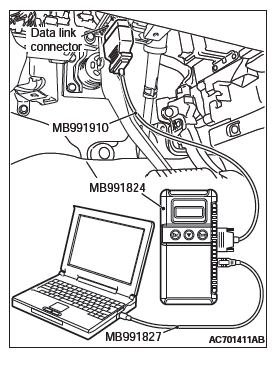
- Erase the DTC.
- Turn the ignition switch to the "ON" position.
- Check if the DTC is set.
- Turn the ignition switch to the "LOCK" (OFF) position.
Q: Is the DTC set?
YES : Go to Step 3.
NO : There is an intermittent malfunction such as poor engaged connector(s) or open circuit.
STEP 3. Check the lap pre-tensioner. (Using scan tool MB991958, read the diagnostic trouble code.)

- Disconnect the negative battery terminal.
- Disconnect lap pre-tensioner connector D-24. Use a flat-tipped screwdriver to unlock the locking button at the harness side connector by withdrawing it toward you in two stages, and then disconnect the connector.

- Connect special tool MB991865 to special tool MB991884.
- Connect special tool MB991884 to the D-24 harness side connector.
- Connect the negative battery terminal.
- Erase diagnostic trouble code memory, and check the diagnostic trouble code.
Q: Is DTC B1C33 set?
YES : Go to Step 4.
NO : Replace the driver's seat belt with pre-tensioner. Then go to Step 6.
STEP 4. Check the lap pre-tensioner circuit. Measure the resistance at the SRS-ECU connector C-27.

- Disconnect the negative battery terminal.
- While pushing the part "A" indicated in the figure of the harness side connector, turn the lock lever to the direction of the arrow to release the lock lever, and disconnect the C-27 SRS-ECU connector.
DANGER To prevent the lap pre-tensioner from deploying unintentionally, disconnect the lap pre-tensioner connector D-24 to short the squib circuit.

- Disconnect lap pre-tensioner connector D-24. Use a flat-tipped screwdriver to unlock the locking button at the harness side connector by withdrawing it toward you in two stages, and then disconnect the connector.

CAUTION Insert an insulator such as a cable tie to a depth of 4mm (0.16 inch) or more, otherwise the short spring will not be released.
- Insert a cable tie [3 mm (0.12 inch) wide, 0.5 mm (0.02 inch) thick] between terminals 35, 36 and the short spring to release the short spring.

- Check for continuity between C-27 harness side connector
terminals 35, 36 and body ground.
It should be an open circuit.
Q: Is it open circuit?
YES : Erase the diagnostic trouble code memory, and check the diagnostic trouble code. If DTC B1C33 sets, replace the SRS-ECU. Then go to Step 6.
NO : Go to Step 5.
STEP 5. Check harness wires for short circuit to ground between SRS-ECU connector C-27 (terminal No.35 and 36) and lap pre-tensioner connector D-24 (terminal No.2 and 1).
Q: Is the check result normal?
YES : Go to Step 6.
NO : Repair the harness wires between SRS-ECU connector C-27 and lap pre-tensioner connector D-24. Then go to Step 6.
STEP 6. Recheck for diagnostic trouble code.
Check again if the DTC is set.

- Erase the DTC.
- Turn the ignition switch to the "ON" position.
- Check if the DTC is set.
- Turn the ignition switch to the "LOCK" (OFF) position.
Q: Is DTC B1C33 set?
YES : Return to Step 1.
NO : The procedure is complete.
DTC B1C34: Driver's Lap Pre-tensioner (Squib) System (Shorted to Squib Circuit Power Supply)
Driver's Lap pre-tensioner (Squib) Circuit


CAUTION If DTC B1C34 is set in the SRS-ECU, always diagnose the CAN main bus line.
CIRCUIT OPERATION
The SRS-ECU judges how severe a collision is by detecting signals from the front impact sensors and the front air bag analog G-sensor. If the impact is over a predetermined level, the SRS-ECU sends an ignition signal. At this time, if the front air bag safing G-sensor is on, the lap pre-tensioner will deploy.
DTC SET CONDITIONS
This DTC is set if there is abnormal resistance between the input terminals of the lap pre-tensioner (squib).
TROUBLESHOOTING HITS
- Damaged wiring harnesses or connectors
- Short to power supply in the lap pre-tensioner (squib) harness
- Malfunction of the SRS-ECU
DIAGNOSIS
Required Special Tools:
- MB991958: Scan Tool (M.U.T.-III Sub Assembly)
- MB991824: Vehicle Communication Interface (V.C.I.)
- MB991827: M.U.T.-III USB Cable
- MB991910: M.U.T.-III Main Harness A (Vehicles with CAN Communication System)
- MB991865: Dummy resistor
- MB991884: Resister harness
STEP 1. Using scan tool MB991958, diagnose the CAN bus line.
CAUTION To prevent damage to scan tool MB991958, always turn the ignition switch to the "LOCK" (OFF) position before connecting or disconnecting scan tool MB991958.
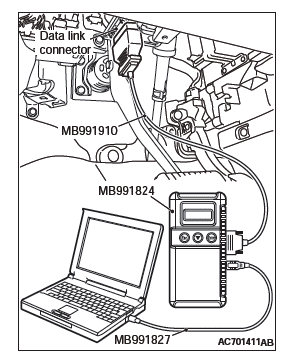
- Connect scan tool MB991958. Refer to "How to connect the scan tool".
- Turn the ignition switch to the "ON" position.
- Diagnose the CAN bus line.
- Turn the ignition switch to the "LOCK" (OFF) position.
Q: Is the CAN bus line found to be normal?
YES : Go to Step 2.
NO : Repair the CAN bus line.
STEP 2. Recheck for diagnostic trouble code.
Check again if the DTC is set.
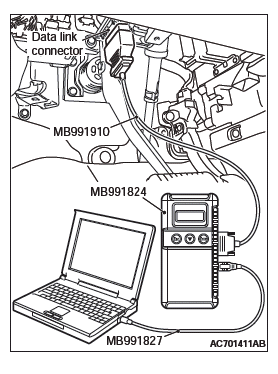
- Erase the DTC.
- Turn the ignition switch to "ON" position.
- Check if the DTC is set.
- Turn the ignition switch to the "LOCK" (OFF) position.
Q: Is the DTC set?
YES : Go to Step 3.
NO : Go to Step 6.
STEP 3. Check the lap pre-tensioner. (Using scan tool MB991958, read the diagnostic trouble code.)

- Disconnect the negative battery terminal.
- Disconnect lap pre-tensioner connector D-24. Use a flat-tipped screwdriver to unlock the locking button at the harness side connector by withdrawing it toward you in two stages, and then disconnect the connector.

- Connect special tool MB991865 to special tool MB991884.
- Connect special tool MB991884 to the D-24 harness side connector.
- Connect the negative battery terminal.
- Erase diagnostic trouble code memory, and check the diagnostic trouble code.
Q: Is DTC B1C34 set?
YES : Go to Step 4.
NO : Replace the driver's seat belt with pre-tensioner. Then go to Step 6.
STEP 4. Check the lap pre-tensioner circuit. Measure the voltage at the SRS-ECU connector C-27.
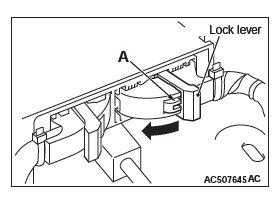
- Disconnect the negative battery terminal.
- While pushing the part "A" indicated in the figure of the harness side connector, turn the lock lever to the direction of the arrow to release the lock lever, and disconnect the C-27 SRS-ECU connector.

DANGER To prevent the lap pre-tensioner from deploying unintentionally, disconnect the lap pre-tensioner connector D-24 to short the squib circuit.
- Disconnect lap pre-tensioner connector D-24. Use a flat-tipped screwdriver to unlock the locking button at the harness side connector by withdrawing it toward you in two stages, and then disconnect the connector.

CAUTION Insert an insulator such as a cable tie to a depth of 4mm (0.16 inch) or more, otherwise the short spring will not be released.
- Insert a cable tie [3 mm (0.12 inch) wide, 0.5 mm (0.02 inch) thick] between terminals 35, 36 and the short spring to release the short spring.
- Connect the negative battery terminal.
- Ignition switch: "ON".

- Measure the voltage between C-27 harness side connector
terminals 35, 36 and body ground.
Voltage should measure 1 volt or less.
Q: Is the measured voltage within the specified range?
YES : Erase the diagnostic trouble code memory, and check the diagnostic trouble code. If DTC B1C34 sets, replace the SRS-ECU. Then go to Step 6.
NO : Go to Step 5.
STEP 5. Check the harness wires for short circuit to power supply between SRS-ECU connector C-27 (terminal No.35 and 36) and lap pre-tensioner connector D-24 (terminal No.2 and 1).
Q: Is the check result normal?
YES : Go to Step 6.
NO : Repair the harness wires between SRS-ECU connector C-27 and lap pre-tensioner connector D-24. Then go to Step 6.
STEP 6. Recheck for diagnostic trouble code.
Check again if the DTC is set.

- Erase the DTC.
- Turn the ignition switch to the "ON" position.
- Check if the DTC is set.
- Turn the ignition switch to the "LOCK" (OFF) position.
Q: Is DTC B1C34 set?
YES : Return to Step 1.
NO : The procedure is complete.
DTC B1C35: Driver's Lap Pre-tensioner (Squib) System (Squib Circuit Open)
Driver's Lap pre-tensioner (Squib) Circuit


CAUTION If DTC B1C35 is set in the SRS-ECU, always diagnose the CAN main bus line.
CIRCUIT OPERATION
The SRS-ECU judges how severe a collision is by detecting signals from the front impact sensors and the front air bag analog G-sensor. If the impact is over a predetermined level, the SRS-ECU sends an ignition signal. At this time, if the front air bag safing G-sensor is on, the lap pre-tensioner will deploy.
DTC SET CONDITIONS
This DTC is set if there is abnormal resistance between the input terminals of the lap pre-tensioner (squib).
TROUBLESHOOTING HITS
- Improper connector contact
- Open circuit in the lap pre-tensioner (squib) circuit
- Malfunction of the SRS-ECU
DIAGNOSIS
Required Special Tools:
- MB991958: Scan Tool (M.U.T.-III Sub Assembly)
- MB991824: Vehicle Communication Interface (V.C.I.)
- MB991827: M.U.T.-III USB Cable
- MB991910: M.U.T.-III Main Harness A (Vehicles with CAN Communication System)
- MB991865: Dummy resistor
- MB991884: Resister harness
STEP 1. Using scan tool MB991958, diagnose the CAN bus line.
CAUTION To prevent damage to scan tool MB991958, always turn the ignition switch to the "LOCK" (OFF) position before connecting or disconnecting scan tool MB991958.

- Connect scan tool MB991958. Refer to "How to connect the scan tool".
- Turn the ignition switch to the "ON" position.
- Diagnose the CAN bus line.
- Turn the ignition switch to the "LOCK" (OFF) position.
Q: Is the CAN bus line found to be normal?
YES : Go to Step 2.
NO : Repair the CAN bus line.
STEP 2. Recheck for diagnostic trouble code.
Check again if the DTC is set.
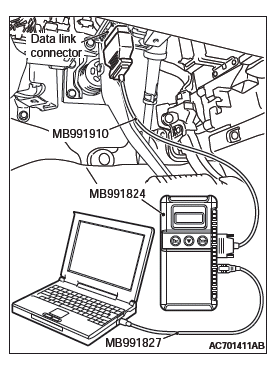
- Erase the DTC.
- Turn the ignition switch to the "ON" position.
- Check if the DTC is set.
- Turn the ignition switch to the "LOCK" (OFF) position.
Q: Is the DTC set?
YES : Go to Step 3.
NO : There is an intermittent malfunction such as poor engaged connector(s) or open circuit.
STEP 3. Check the lap pre-tensioner. (Using scan tool MB991958, read the diagnostic trouble code.)
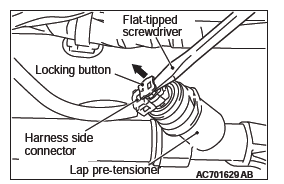
- Disconnect the negative battery terminal.
- Disconnect lap pre-tensioner connector D-24. Use a flat-tipped screwdriver to unlock the locking button at the harness side connector by withdrawing it toward you in two stages, and then disconnect the connector.

- Connect special tool MB991865 to special tool MB991884.
- Connect special tool MB991884 to the D-24 harness side connector.
- Connect the negative battery terminal.
- Erase diagnostic trouble code memory, and then check the diagnostic trouble code.
Q: Is DTC B1C35 set?
YES : Go to Step 4.
NO : Replace the driver's seat belt with pre-tensioner. Then go to Step 5.
STEP 4. Check the harness for open circuit between SRS-ECU connector C-27 (terminal No.35 and 36) and the lap pre-tensioner D-24 (terminal No.2 and 1).

- Disconnect the negative battery terminal.
- While pushing the part "A" indicated in the figure of the harness side connector, turn the lock lever to the direction of the arrow to release the lock lever, and disconnect the C-27 SRS-ECU connector.
DANGER To prevent the lap pre-tensioner from deploying unintentionally, disconnect the lap pre-tensioner connector D-24 to short the squib circuit.

- Disconnect SRS-ECU connector C-27 and lap pre-tensioner connector D-24, and measure at the wiring harness side. For connector D-24, use a flat-tipped screwdriver to unlock the locking button at the harness side connector by withdrawing it toward you in two stages, and then disconnect the connector.
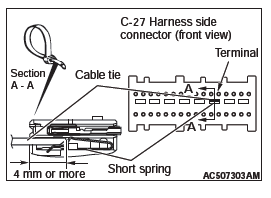
CAUTION Insert an insulator such as a cable tie to a depth of 4mm (0.16 inch) or more, otherwise the short spring will not be released.
- Insert a cable tie [3 mm (0.12 inch) wide, 0.5 mm (0.02 inch) thick] between terminals 35, 36 and the short spring to release the short spring.

- Connect D-24 harness side connector to special tool MB991884.
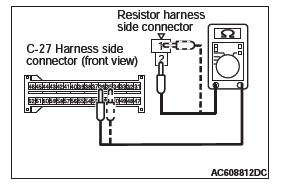
- Check for continuity between the following terminals. It should be less than 2 ohms.
- SRS-ECU connector C-27 (terminal No.35) and the special tool (terminal No.1)
- SRS-ECU connector C-27 (terminal No.36) and the special tool (terminal No.2)
Q: Does continuity exist?
YES : Erase the diagnostic trouble code memory, and recheck if any DTC set. If DTC B1C35 set, replace the SRS-ECU. Then go to Step 5.
NO : Repair the harness wires between SRS-ECU connector C-27 and lap pre-tensioner connector D-24. Then go to Step 5.
STEP 5. Recheck for diagnostic trouble code.
Check again if the DTC is set.

- Erase the DTC.
- Turn the ignition switch to the "ON" position.
- Check if the DTC is set.
- Turn the ignition switch to the "LOCK" (OFF) position.
Q: Is DTC B1C35 set?
YES : Return to Step 1.
NO : The procedure is complete.
DTC B1C36: Driver's Lap Pre-tensioner (Squib) System (Short Circuit between Squib Circuit Terminals)
Driver's Lap pre-tensioner (Squib) Circuit


CAUTION If DTC B1C36 is set in the SRS-ECU, always diagnose the CAN main bus line.
CIRCUIT OPERATION
The SRS-ECU judges how severe a collision is by detecting signals from the front impact sensors and the front air bag analog G-sensor. If the impact is over a predetermined level, the SRS-ECU sends an ignition signal. At this time, if the front air bag safing G-sensor is on, the lap pre-tensioner will deploy.
DTC SET CONDITIONS
This DTC is set if there is abnormal resistance between the input terminals of the lap pre-tensioner (squib).
TROUBLESHOOTING HITS
- Improper engaged connector or defective short spring*
- Short circuit between the lap pre-tensioner (squib) circuit terminals
- Damaged connector(s)
NOTE: *: The squib circuit connectors integrate a "short" spring (which prevents the lap pre-tensioner from deploying unintentionally due to static electricity by shorting the positive wire to the ground wire in the squib circuit when the connectors are disconnected). Therefore, if connector C-27 or D-24 is damaged or improperly engaged, the short spring may not be released when the connector is connected.
DIAGNOSIS
Required Special Tools:
- MB991958: Scan Tool (M.U.T.-III Sub Assembly)
- MB991824: Vehicle Communication Interface (V.C.I.)
- MB991827: M.U.T.-III USB Cable
- MB991910: M.U.T.-III Main Harness A (Vehicles with CAN Communication System)
- MB991865: Dummy resistor
- MB991884: Resister harness
STEP 1. Using scan tool MB991958, diagnose the CAN bus line.
CAUTION To prevent damage to scan tool MB991958, always turn the ignition switch to the "LOCK" (OFF) position before connecting or disconnecting scan tool MB991958.
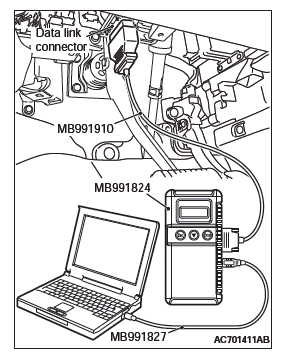
- Connect scan tool MB991958. Refer to "How to connect the scan tool".
- Turn the ignition switch to the "ON" position.
- Diagnose the CAN bus line.
- Turn the ignition switch to the "LOCK" (OFF) position.
Q: Is the CAN bus line found to be normal?
YES : Go to Step 2 .
NO : Repair the CAN bus line.
STEP 2. Recheck for diagnostic trouble code.
Check again if the DTC is set.
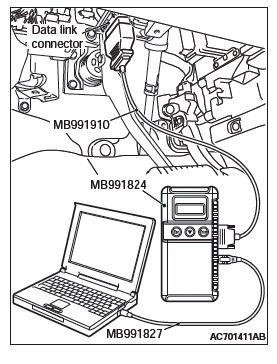
- Erase the DTC.
- Turn the ignition switch to "ON" position.
- Check if the DTC is set.
- Turn the ignition switch to the "LOCK" (OFF) position.
Q: Is the DTC set?
YES : Go to Step 3 .
NO : There is an intermittent malfunction such as poor engaged connector(s) or open circuit.
STEP 3. Check SRS-ECU connector C-27 and lap pre-tensioner connector D-24. (Using scan tool MB991958, read the diagnostic trouble code.)

- Disconnect the negative battery terminal.
- While pushing the part "A" indicated in the figure of the harness side connector, turn the lock lever to the direction of the arrow to release the lock lever, and disconnect the C-27 SRS-ECU connector. Then connect the connector.
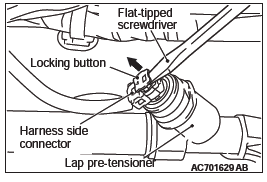
- After disconnecting the D-24 harness side connectors, connect the connectors again. For the D-24 connector disconnection, use a flat-tipped screwdriver to unlock the locking button at the harness side connector by withdrawing it toward you in two stages, and then disconnect the connector.
- Connector the negative battery terminal.
- Erase the diagnostic trouble code memory, and check the diagnostic trouble code.
Q: Is DTC B1C36 set?
YES : Go to Step 4.
NO : The procedure is complete. It is assumed that DTC B1C36 set because connector C-27 or D-24 was engaged improperly.
STEP 4. Check the lap pre-tensioner. (Using scan tool MB991958, read the diagnostic trouble code.)
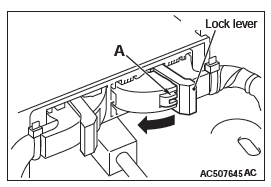
- Disconnect the negative battery terminal.
- While pushing the part "A" indicated in the figure of the harness side connector, turn the lock lever to the direction of the arrow to release the lock lever, and disconnect the C-27 SRS-ECU connector.

- Disconnect lap pre-tensioner connector D-24. Use a flat-tipped screwdriver to unlock the locking button at the harness side connector by withdrawing it toward you in two stages, and then disconnect the connector.

- Connect special tool MB991865 to special tool MB991884.
- Connect special tool MB991884 to the D-24 harness side connector.
- Connect the negative battery terminal.
- Erase diagnostic trouble code memory, and then check the diagnostic trouble code.
Q: Is DTC B1C36 set?
YES : Go to Step 5.
NO : Replace the driver's seat belt with pre-tensioner. Then go to Step 7.
STEP 5. Check the lap pre-tensioner circuit. Measure the resistance at the SRS-ECU connector C-27.

- Disconnect the negative battery terminal.
- While pushing the part "A" indicated in the figure of the harness side connector, turn the lock lever to the direction of the arrow to release the lock lever, and disconnect the C-27 SRS-ECU connector.
DANGER To prevent the lap pre-tensioner from deploying unintentionally, disconnect the lap pre-tensioner connector D-24 to short the squib circuit.

- Disconnect lap pre-tensioner connector D-24. Use a flat-tipped screwdriver to unlock the locking button at the harness side connector by withdrawing it toward you in two stages, and then disconnect the connector.

CAUTION Insert an insulator such as a cable tie to a depth of 4mm (0.16 inch) or more, otherwise the short spring will not be released.
- Insert a cable tie [3 mm (0.12 inch) wide, 0.5 mm (0.02 inch) thick] between terminals 35, 36 and the short spring to release the short spring.

- Check for continuity between C-27 harness side connector
terminals 35 and 36.
It should be an open circuit.
Q: Is it open circuit?
YES : Erase the diagnostic trouble code memory, and check the diagnostic trouble code. If DTC B1C36 sets, replace the SRS-ECU. Then go to Step 7.
NO : Go to Step 6.
STEP 6. Check the harness for short circuit between SRS-ECU connector C-27 (terminal No.35 and 36) and lap pre-tensioner connector D-24 (terminal No.2 and 1).
Q: Is the check result normal?
YES : Go to Step 7.
NO : Repair the harness wires between SRS-ECU connector C-27 and lap pre-tensioner connector D-24. Then go to Step 7.
STEP 7. Recheck for diagnostic trouble code.
Check again if the DTC is set.
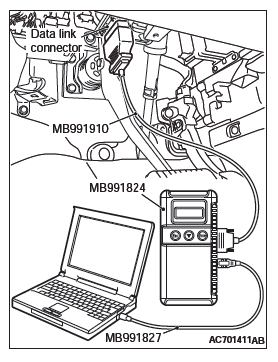
- Erase the DTC.
- Turn the ignition switch to the "ON" position.
- Check if the DTC is set.
- Turn the ignition switch to the "LOCK" (OFF) position.
Q: Is DTC B1C36 set?
YES : Return to Step 1.
NO : The procedure is complete.
DTC B1C38 Driver's Seat Belt Pre-tensioner (squib) System (Shorted to Squib Circuit Ground)
Seat Belt Pre-Tensioner (Driver's side) (Squib) Circuit


CAUTION If DTC B1C38 is set in the SRS-ECU, always diagnose the CAN main bus line.
CIRCUIT OPERATION
The SRS-ECU judges how severe a collision is by detecting signals from the front impact sensors and the front air bag analog G-sensor. If the impact is over a predetermined level, the SRS-ECU sends an ignition signal. At this time, if the front air bag safing G-sensor is on, the pre-tensioner will deploy.
DTC SET CONDITIONS
This DTC is set if there is abnormal resistance between the input terminals of the driver's seat belt pre-tensioner (squib).
TROUBLESHOOTING HITS
- Damaged wiring harnesses or connectors
- Short to the ground in the driver's seat belt pre-tensioner (squib) harness
- Malfunction of the SRS-ECU
DIAGNOSIS
Required Special Tools:
- MB991958: Scan Tool (M.U.T.-III Sub Assembly)
- MB991824: Vehicle Communication Interface (V.C.I.)
- MB991827: M.U.T.-III USB Cable
- MB991910: M.U.T.-III Main Harness A (Vehicles with CAN Communication System)
- MB991865: Dummy resistor
- MB991884: Resister harness
STEP 1. Using scan tool MB991958, diagnose the CAN bus line.
CAUTION To prevent damage to scan tool MB991958, always turn the ignition switch to the "LOCK" (OFF) position before connecting or disconnecting scan tool MB991958.

- Connect scan tool MB991958. Refer to "How to connect the scan tool".
- Turn the ignition switch to the "ON" position.
- Diagnose the CAN bus line.
- Turn the ignition switch to the "LOCK" (OFF) position.
Q: Is the CAN bus line found to be normal?
YES : Go to Step 2.
NO : Repair the CAN bus line.
STEP 2. Recheck for diagnostic trouble code.
Check again if the DTC is set.

- Erase the DTC.
- Turn the ignition switch to the "ON" position.
- Check if the DTC is set.
- Turn the ignition switch to the "LOCK" (OFF) position.
Q: Is the DTC set?
YES : Go to Step 3.
NO : There is an intermittent malfunction such as poor engaged connector(s) or open circuit.
STEP 3. Check the driver's seat belt pre-tensioner. (Using scan tool MB991958, read the diagnostic trouble code.)

- Disconnect the negative battery terminal.
- Disconnect driver's seat belt pre-tensioner connector D-121. Use a flat-tipped screwdriver to unlock the locking button at the harness side connector by withdrawing it toward you in two stages, and then disconnect the connector.

- Connect special tool MB991865 to special tool MB991884.
- Connect special tool MB991884 to the D-121 harness side connector.
- Connect the negative battery terminal.
- Erase diagnostic trouble code memory, and check the diagnostic trouble code.
Q: Is DTC B1C38 set?
YES : Go to Step 4.
NO : Replace the driver's seat belt with pre-tensioner. Then go to Step 6.
STEP 4. Check the driver's seat belt pre-tensioner circuit.
Measure the resistance at the SRS-ECU connector C-27.

- Disconnect the negative battery terminal.
- While pushing the part "A" indicated in the figure of the harness side connector, turn the lock lever to the direction of the arrow to release the lock lever, and disconnect the C-27 SRS-ECU connector.

DANGER To prevent the seat belt pre-tensioner from deploying unintentionally, disconnect the driver's seat belt pre-tensioner connector D-121 to short the squib circuit.
- Disconnect driver's seat belt pre-tensioner connector D-121. Use a flat-tipped screwdriver to unlock the locking button at the harness side connector by withdrawing it toward you in two stages, and then disconnect the connector.

CAUTION Insert an insulator such as a cable tie to a depth of 4mm (0.16 inch) or more, otherwise the short spring will not be released.
- Insert a cable tie [3 mm (0.12 inch) wide, 0.5 mm (0.02 inch) thick] between terminals 45, 46 and the short spring to release the short spring.

- Check for continuity between C-27 harness side connector
terminals 45, 46 and body ground.
It should be an open circuit.
Q: Is it open circuit?
YES : Erase the diagnostic trouble code memory, and check the diagnostic trouble code. If DTC B1C38 sets, replace the SRS-ECU. Then go to Step 6.
NO : Go to Step 5.
STEP 5. Check harness wires for short circuit to ground between SRS-ECU connector C-27 (terminal No.45 and 46) and driver's seat belt pre-tensioner connector D-121 (terminal No.1 and 2).
Q: Is the check result normal?
YES : Go to Step 6.
NO : Repair the harness wires between SRS-ECU connector C-27 and driver's seat belt pre-tensioner connector D-121. Then go to Step 6.
STEP 6. Recheck for diagnostic trouble code.
Check again if the DTC is set.

- Erase the DTC.
- Turn the ignition switch to the "ON" position.
- Check if the DTC is set.
- Turn the ignition switch to the "LOCK" (OFF) position.
Q: Is DTC B1C38 set?
YES : Return to Step 1.
NO : The procedure is complete.
DTC B1C39: Driver's Seat Belt Pre-tensioner (Squib) System (Shorted to Squib Circuit Power Supply)
Seat Belt Pre-Tensioner (Driver's side) (Squib) Circuit


CAUTION If DTC B1C39 is set in the SRS-ECU, always diagnose the CAN main bus line.
CIRCUIT OPERATION
The SRS-ECU judges how severe a collision is by detecting signals from the front impact sensors and the front air bag analog G-sensor. If the impact is over a predetermined level, the SRS-ECU sends an ignition signal. At this time, if the front air bag safing G-sensor is on, the pre-tensioner will deploy.
DTC SET CONDITIONS
This DTC is set if there is abnormal resistance between the input terminals of the driver's seat belt pre-tensioner (squib).
TROUBLESHOOTING HITS
- Damaged wiring harnesses or connectors
- Short to the power supply in the driver's seat belt pre-tensioner (squib) harness
- Malfunction of the SRS-ECU
DIAGNOSIS
Required Special Tools:
- MB991958: Scan Tool (M.U.T.-III Sub Assembly)
- MB991824: Vehicle Communication Interface (V.C.I.)
- MB991827: M.U.T.-III USB Cable
- MB991910: M.U.T.-III Main Harness A (Vehicles with CAN Communication System)
- MB991865: Dummy resistor
- MB991884: Resister harness
STEP 1. Using scan tool MB991958, diagnose the CAN bus line.
CAUTION To prevent damage to scan tool MB991958, always turn the ignition switch to the "LOCK" (OFF) position before connecting or disconnecting scan tool MB991958.

- Connect scan tool MB991958. Refer to "How to connect the scan tool".
- Turn the ignition switch to the "ON" position.
- Diagnose the CAN bus line.
- Turn the ignition switch to the "LOCK" (OFF) position.
Q: Is the CAN bus line found to be normal?
YES : Go to Step 2.
NO : Repair the CAN bus line.
STEP 2. Recheck for diagnostic trouble code.
Check again if the DTC is set.
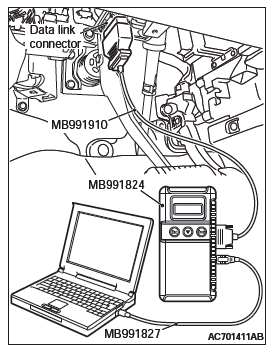
- Erase the DTC.
- Turn the ignition switch to "ON" position.
- Check if the DTC is set.
- Turn the ignition switch to the "LOCK" (OFF) position.
Q: Is the DTC set?
YES : Go to Step 3.
NO : Go to Step 6.
STEP 3. Check the driver's seat belt pre-tensioner. (Using scan tool MB991958, read the diagnostic trouble code.)

- Disconnect the negative battery terminal.
- Disconnect driver's seat belt pre-tensioner connector D-121. Use a flat-tipped screwdriver to unlock the locking button at the harness side connector by withdrawing it toward you in two stages, and then disconnect the connector.

- Connect special tool MB991865 to special tool MB991884.
- Connect special tool MB991884 to the D-121 harness side connector.
- Connect the negative battery terminal.
- Erase diagnostic trouble code memory, and check the diagnostic trouble code.
Q: Is DTC B1C39 set?
YES : Go to Step 4.
NO : Replace the driver's seat belt with pre-tensioner. Then go to Step 6.
STEP 4. Check the driver's seat belt pre-tensioner circuit.
Measure the voltage at the SRS-ECU connector C-27.
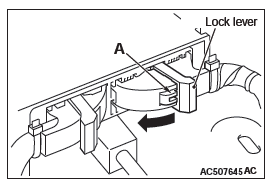
- Disconnect the negative battery terminal.
- While pushing the part "A" indicated in the figure of the harness side connector, turn the lock lever to the direction of the arrow to release the lock lever, and disconnect the C-27 SRS-ECU connector.
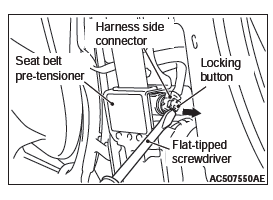
DANGER To prevent the seat belt pre-tensioner from deploying unintentionally, disconnect the driver's seat belt pre-tensioner connector D-121 to short the squib circuit.
- Disconnect driver's seat belt pre-tensioner connector D-121. Use a flat-tipped screwdriver to unlock the locking button at the harness side connector by withdrawing it toward you in two stages, and then disconnect the connector.
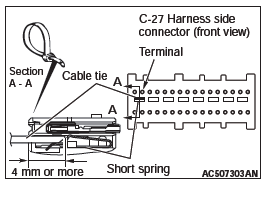
CAUTION Insert an insulator such as a cable tie to a depth of 4mm (0.16 inch) or more, otherwise the short spring will not be released.
- Insert a cable tie [3 mm (0.12 inch) wide, 0.5 mm (0.02 inch) thick] between terminals 45, 46 and the short spring to release the short spring.
- Connect the negative battery terminal.
- Ignition switch: "ON".

- Measure the voltage between C-27 harness side connector
terminals 45, 46 and body ground.
Voltage should measure 1 volt or less.
Q: Is the measured voltage within the specified range?
YES : Erase the diagnostic trouble code memory, and check the diagnostic trouble code. If DTC B1C39 sets, replace the SRS-ECU. Then go to Step 6.
NO : Go to Step 5.
STEP 5. Check the harness wires for short circuit to power supply between SRS-ECU connector C-27 (terminal No.45 and 46) and driver's seat belt pre-tensioner connector D-121 (terminal No.1 and 2).
Q: Is the check result normal?
YES : Go to Step 6.
NO : Repair the harness wires between SRS-ECU connector C-27 and driver's seat belt pre-tensioner connector D-121. Then go to Step 6.
STEP 6. Recheck for diagnostic trouble code.
Check again if the DTC is set.

- Erase the DTC.
- Turn the ignition switch to the "ON" position.
- Check if the DTC is set.
- Turn the ignition switch to the "LOCK" (OFF) position.
Q: Is DTC B1C39 set?
YES : Return to Step 1.
NO : The procedure is complete.
DTC B1C3A: Driver's Seat Belt Pre-tensioner (Squib) System (Squib Circuit Open)
Seat Belt Pre-Tensioner (Driver's side) (Squib) Circuit


CAUTION If DTC B1C3A is set in the SRS-ECU, always diagnose the CAN main bus line.
CIRCUIT OPERATION
The SRS-ECU judges how severe a collision is by detecting signals from the front impact sensors and the front air bag analog G-sensor. If the impact is over a predetermined level, the SRS-ECU sends an ignition signal. At this time, if the front air bag safing G-sensor is on, the pre-tensioner will deploy.
DTC SET CONDITIONS
This DTC is set if there is abnormal resistance between the input terminals of the driver's seat belt pre-tensioner (squib).
TROUBLESHOOTING HITS
- Improper connector contact
- Open circuit in the driver's seat belt pre-tensioner (squib) circuit
- Malfunction of the SRS-ECU
DIAGNOSIS
Required Special Tools:
- MB991958: Scan Tool (M.U.T.-III Sub Assembly)
- MB991824: Vehicle Communication Interface (V.C.I.)
- MB991827: M.U.T.-III USB Cable
- MB991910: M.U.T.-III Main Harness A (Vehicles with CAN Communication System)
- MB991865: Dummy resistor
- MB991884: Resister harness
STEP 1. Using scan tool MB991958, diagnose the CAN bus line.
CAUTION To prevent damage to scan tool MB991958, always turn the ignition switch to the "LOCK" (OFF) position before connecting or disconnecting scan tool MB991958.
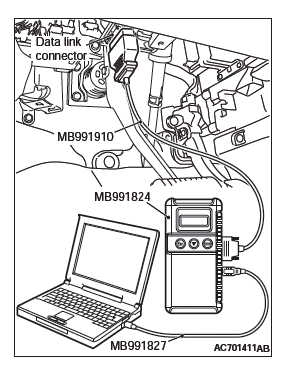
- Connect scan tool MB991958. Refer to "How to connect the scan tool".
- Turn the ignition switch to the "ON" position.
- Diagnose the CAN bus line.
- Turn the ignition switch to the "LOCK" (OFF) position.
Q: Is the CAN bus line found to be normal?
YES : Go to Step 2.
NO : Repair the CAN bus line.
STEP 2. Recheck for diagnostic trouble code.
Check again if the DTC is set.

- Erase the DTC.
- Turn the ignition switch to the "ON" position.
- Check if the DTC is set.
- Turn the ignition switch to the "LOCK" (OFF) position.
Q: Is the DTC set?
YES : Go to Step 3.
NO : There is an intermittent malfunction such as poor engaged connector(s) or open circuit (Refer to GROUP 00, How to Cope with Intermittent Malfunction).
STEP 3. Check the driver's seat belt pre-tensioner. (Using scan tool MB991958, read the diagnostic trouble code.)
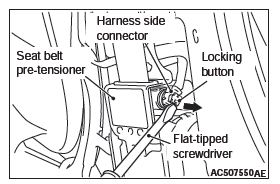
- Disconnect the negative battery terminal.
- Disconnect driver's seat belt pre-tensioner connector D-121. Use a flat-tipped screwdriver to unlock the locking button at the harness side connector by withdrawing it toward you in two stages, and then disconnect the connector.

- Connect special tool MB991865 to special tool MB991884.
- Connect special tool MB991884 to the D-121 harness side connector.
- Connect the negative battery terminal.
- Erase diagnostic trouble code memory, and then check the diagnostic trouble code.
Q: Is DTC B1C3A set?
YES : Go to Step 4.
NO : Replace the driver's seat belt with pre-tensioner. Then go to Step 5.
STEP 4. Check the harness for open circuit between SRS-ECU connector C-27 (terminal No.45 and 46) and the driver's seat belt pre-tensioner D-121 (terminal No.1 and 2).

- Disconnect the negative battery terminal.
- While pushing the part "A" indicated in the figure of the harness side connector, turn the lock lever to the direction of the arrow to release the lock lever, and disconnect the C-27 SRS-ECU connector.

DANGER To prevent the seat belt pre-tensioner from deploying unintentionally, disconnect the driver's seat belt pre-tensioner connector D-121 to short the squib circuit.
- Disconnect SRS-ECU connector C-27 and driver's seat belt pre-tensioner connector D-121, and measure at the wiring harness side. For connector D-121, use a flat-tipped screwdriver to unlock the locking button at the harness side connector by withdrawing it toward you in two stages, and then disconnect the connector.

- Insert a cable tie [3 mm (0.12 inch) wide, 0.5 mm (0.02 inch) thick] between terminals 45, 46 and the short spring to release the short spring.

- Connect D-121 harness side connector to special tool MB991884.

- Check for continuity between the following terminals. It should be less than 2 ohms.
- SRS-ECU connector C-27 (terminal No.45) and the special tool (terminal No.2)
- SRS-ECU connector C-27 (terminal No.46) and the special tool (terminal No.1)
Q: Does continuity exist?
YES : Erase the diagnostic trouble code memory, and recheck if any DTC set. If DTC B1C3A set, replace the SRS-ECU. Then go to Step 5.
NO : Repair harness wires between SRS-ECU connector C-27 and driver's seat belt pre-tensioner connector D-121. Then go to Step 5.
STEP 5. Recheck for diagnostic trouble code.
Check again if the DTC is set.

- Erase the DTC.
- Turn the ignition switch to the "ON" position.
- Check if the DTC is set.
- Turn the ignition switch to the "LOCK" (OFF) position.
Q: Is DTC B1C3A set?
YES : Return to Step 1.
NO : The procedure is complete.
DTC B1C3B: Driver's Seat Belt Pre-tensioner (Squib) System (Short Circuit between Squib Circuit Terminals)
Seat Belt Pre-Tensioner (Driver's side) (Squib) Circuit


CAUTION If DTC B1C3B is set in the SRS-ECU, always diagnose the CAN main bus line.
CIRCUIT OPERATION
The SRS-ECU judges how severe a collision is by detecting signals from the front impact sensors and the front air bag analog G-sensor. If the impact is over a predetermined level, the SRS-ECU sends an ignition signal. At this time, if the front air bag safing G-sensor is on, the pre-tensioner will deploy.
DTC SET CONDITIONS
This DTC is set if there is abnormal resistance between the input terminals of the driver's side seat belt pre-tensioner (squib).
TROUBLESHOOTING HITS
- Improper engaged connector or defective short spring*
- Short circuit between the driver's seat belt pre-tensioner (squib) circuit terminals
- Damaged connector(s)
- Malfunction of the SRS-ECU
NOTE: *: The squib circuit connectors integrate a "short" spring (which prevents the seat belt pre-tensioner from deploying unintentionally due to static electricity by shorting the positive wire to the ground wire in the squib circuit when the connectors are disconnected). Therefore, if connector C-27 or D-121 is damaged or improperly engaged, the short spring may not be released when the connector is connected.
DIAGNOSIS
Required Special Tools:
- MB991958: Scan Tool (M.U.T.-III Sub Assembly)
- MB991824: Vehicle Communication Interface (V.C.I.)
- MB991827: M.U.T.-III USB Cable
- MB991910: M.U.T.-III Main Harness A (Vehicles with CAN Communication System)
- MB991865: Dummy resistor
- MB991884: Resister harness
STEP 1. Using scan tool MB991958, diagnose the CAN bus line.
CAUTION To prevent damage to scan tool MB991958, always turn the ignition switch to the "LOCK" (OFF) position before connecting or disconnecting scan tool MB991958.

- Connect scan tool MB991958. Refer to "How to connect the scan tool".
- Turn the ignition switch to the "ON" position.
- Diagnose the CAN bus line.
- Turn the ignition switch to the "LOCK" (OFF) position.
Q: Is the CAN bus line found to be normal?
YES : Go to Step 2 .
NO : Repair the CAN bus line.
STEP 2. Recheck for diagnostic trouble code.
Check again if the DTC is set.
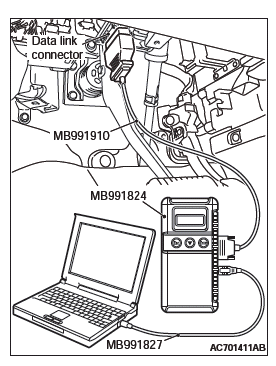
- Erase the DTC.
- Turn the ignition switch to "ON" position.
- Check if the DTC is set.
- Turn the ignition switch to the "LOCK" (OFF) position.
Q: Is the DTC set?
YES : Go to Step 3 .
NO : There is an intermittent malfunction such as poor engaged connector(s) or open circuit (Refer to GROUP 00, How to Cope with Intermittent Malfunction).
STEP 3. Check SRS-ECU connector C-27 and driver's seat belt pre-tensioner connector D-121. (Using scan tool MB991958, read the diagnostic trouble code.)

- Disconnect the negative battery terminal.
- While pushing the part "A" indicated in the figure of the harness side connector, turn the lock lever to the direction of the arrow to release the lock lever, and disconnect the C-27 SRS-ECU connector. Then connect the connector.

- After disconnecting the D-121 harness side connectors, connect the connectors again. For the D-121 connector disconnection, use a flat-tipped screwdriver to unlock the locking button at the harness side connector by withdrawing it toward you in two stages, and then disconnect the connector.
- Connector the negative battery terminal.
- Erase the diagnostic trouble code memory, and check the diagnostic trouble code.
Q: Is DTC B1C3B set?
YES : Go to Step 4.
NO : The procedure is complete. It is assumed that DTC B1C3B set because connector C-27 or D-121 was engaged improperly.
STEP 4. Check the driver's seat belt pre-tensioner. (Using
scan tool MB991958, reaREAD NEXT:
DTC B1C47: Front Passenger's Seat Belt Pre-tensioner (Squib) System
(Shorted to Squib Circuit
Ground)
Seat Belt Pre-Tensioner (passenger's side) (Squib) Circuit
CAUTION
If DTC B1C47 is set in the S
 DTC B1C47, B1C48, B1C49, B1C4A, B210D, B212C, B212D
DTC B1C47, B1C48, B1C49, B1C4A, B210D, B212C, B212D
DTC U0019: Bus Off (CAN-B)
CAUTION
If the DTC U0019 is set, be sure to diagnose
the CAN main bus line.
When replacing the ECU, always check that
the communication circuit is normal.
DTC SET COND
 DTC U0019, U0141, U0154, U0155, U0164, U0168, U0170, U0171, U0172, U0173, U0175,
U0176, U0184, U0195, U0212, U1414, U1415
DTC U0019, U0141, U0154, U0155, U0164, U0168, U0170, U0171, U0172, U0173, U0175,
U0176, U0184, U0195, U0212, U1414, U1415
DTC B1B78: Passenger Seat Weight Sensor (front: LH) Performance
DTC B1B7D: Passenger Seat Weight Sensor (front: RH) Performance
DTC B1B82: Passenger Seat Weight Sensor (rear: LH) Performance
DTC B1B87
 DTC B1B78, B1B79, B1B7A, B1B7D, B1B7E, B1B7F, B1B82, B1B83, B1B84, B1B87,
B1B88, B1B89, B1B8C, B1B8D, B1B8E, B1B91, B1BA7, B1BA8
DTC B1B78, B1B79, B1B7A, B1B7D, B1B7E, B1B7F, B1B82, B1B83, B1B84, B1B87,
B1B88, B1B89, B1B8C, B1B8D, B1B8E, B1B91, B1BA7, B1BA8
SEE MORE:
REMOVAL AND INSTALLATION
CAUTION
When the engine assembly replacement is performed, use scan tool MB991958
to initialize the learning
value.
Pre-removal operation
Hood Removal
Fuel Line Pressure Reduction
Engine Room Under Cover Front and Engine Room Side
Cover Removal
Engine Coolant Drai
 Engine Assembly
Engine Assembly
The fusible links will melt to prevent a fire if a large current attempts to
flow through certain electrical systems.
In case of a melted fuse link, we recommend you to have your vehicle inspected.
For the fusible links, please refer to “Fuse load capacity”.
WARNING:
● Fusible links
 Fusible links
Fusible links
